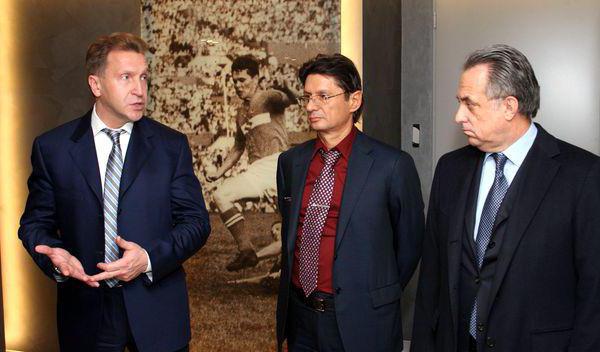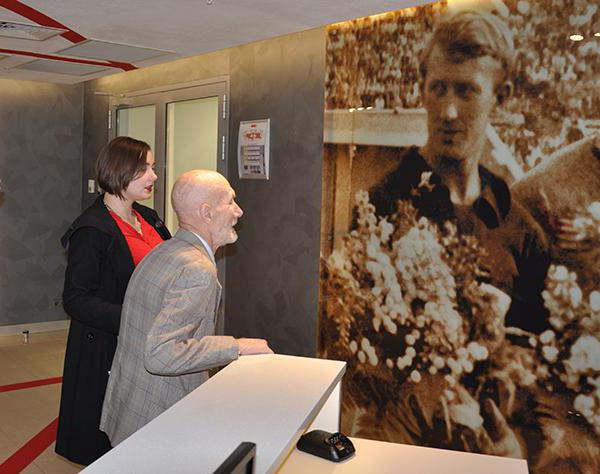Many spiteful critics often say with certainty that Russian athletes have long stopped playing football, but the staff of the main metropolitan club managed to demonstrate - this has not always been the case. With the help of members of the sports team, the museum of the Spartak football club was created. It contains a unique collection of important virtual and material artifacts, there is a hall of fame for players, and those who are far from football will certainly be interested in a stunning technological and interactive exhibition.
History of the opening of the museum
Officially, the Spartak Museum in Moscow was opened for visits a few hours before the start of the friendly match between the football teams of Lithuania and Russia, which took place on April 16, 2016 at the club’s home stadium called Otkritie Arena. The ceremony was held in the presence of the chairman of the board of directors of FC Spartak-Moscow Leonid Fedun, the first vice-premier of the RFU Nikita Simonyan, the minister of Russian sports Vitaly Mutko, the Olympic champions of 1956 Anatoly Isaev, Alexei Paramonov, as well as the head coach of the red-white Dmitry Alenichev and CEO Sergei Rodionov. The youth team coach Dmitry Gunko, team coach Yegor Titov, goalkeeper specialist Rinat Dasaev and their families were also present. They all carefully studied each zone, after which they expressed gratitude to everyone who helped create the Spartak Museum.

It is worth noting that the curator of the historical part of the exposition and the director of the facility is Alexei Matveev, who has many years of experience as a press attache of FC Spartak. The project was carried out over two years with the help of 50 diverse specialists.
What was the museum created for?
In almost two years of its existence, the Spartak Museum, which tells the story of the main football club of the capital of the Russian Federation, has become a landmark for all of Russian football. It has no analogues in the country. Specialists managed to realize the main idea of the creators - to inspire young football players, their fans and visitors who are not indifferent to sports, to new victories and achievements. In addition, the founders intend to constantly replenish the museum with new exhibits and future awards, for which they specifically left a place in the windows.
Museum guests will be able to learn about the history of the titled Russian club, review historical artifacts put together, see unique videos from legendary football matches, listen to fascinating interviews, as well as gather information about the coaching team, players, cups won and other awards.
How to get to the museum, where it is located
The Spartak Museum is located on the 4th floor of the Western Grandstand, which is located in the home stadium of the Otkrytie Arena club. You can find it at the address: Volokolamsk highway, 69, in Moscow. To get to the cultural and historical site, you need to get to the following metro stations:
- Spartak (about 5 minutes walk to the stadium);
- Tushinskaya (about 10 minutes walk).
Also near Art. m. "Tushinskaya" is the stop of most buses and minibuses.
It is worth noting that during the days of football matches, the operating hours of the Spartak metro station (for passengers entering and leaving) does not change.
Museum Schedule
You can stroll through the magnificent territory on any day except Monday. Opening hours of the Spartak Museum:
- Tours are organized Monday through Friday hourly, from 12:00 to 18:00. Their duration is 45 minutes.
- On Saturday and Sunday, as well as on holidays, excursions are held every hour from 11:30 to 17:30 (break from 14:30 to 15:30).
Ticket price
Often tours in the Spartak Museum are held for groups of 8-10 people, but sometimes there are exceptions, and then 25 visitors can listen to the history of the legendary team right away. If you have not booked a standard tour and have not booked it in advance, then the ticket price for adult visitors will be 500 rubles, and for children aged 7 to 16 years - 250 rubles. Pensioners holding the appropriate certificate will be able to buy a ticket at a 50% discount - for 250 rubles.
Tickets for individual tours must be booked no later than one day before the planned date of visit. Such excursions will cost adults 800 rubles, minors and pensioners 400 rubles. Only up to 5 adult tickets are allowed.
It is worth noting that free of charge the Spartak Museum can be visited by veterans of the Second World War, children under 6 years of age, disabled people of group 1, as well as those players who took part in at least one official match for the main team of the white-red team.
Tickets are sold online on the museum’s website and in the Red-White Store located in the stadium.
What can be seen in the museum
First of all, the Spartak Museum boasts its gigantic territory, which is 500 square meters. meters and is divided into 30 thematic zones. In addition, it contains:
- 10 thousand photos;
- 700 videos;
- over 600 exhibits;
- more than 20 copyright installations.
The exposition was based on some personal items of many famous footballers who became legends, and various club trophies. So, here you can see the boots of the talented player of the 80s Fedor Cherenkov, goalkeeper gloves and autographed T-shirts, as well as the USSR’s crystal Cup in silver frame, won in 1992. Digital content contains video materials with the best goals of the players of the red-white team and successful attacks, demonstrates the evolution of the club's game form. Simply move the tablet, reading the details, or rotate the mannequin around its axis. The book of records, the hologram of which can be viewed by “flipping through” directly in the air, is also digitally displayed. Most of the photos in the Spartak Museum are presented in the form of “living” portraits with built-in audio recording. They allow visitors to listen to a bright, unique story about some personalities, their interviews and comments on matches.

There are other objects in the museum that cause pride in the team - a red-and-white pennant with the symbols of the Spartak game club, which was taken by an astronaut-fan Sergei Ryazansky into orbit, and a flag that visited Mount Everest. There is also a ball autographed by Russian President Vladimir Putin. On a separate means of transmitting information, visitors can hear interviews of those fans of the team who glorified Spartak in an unusual way.
In addition, the museum has an unusual hall, about which many joke that it was created “for growth”, since the creators left a place for new trophies and photos of the rising stars of FC Spartak. Since 2003, the club has not been able to win significant awards, so all expositions should inspire a new generation of athletes for feats.
It is worth noting that next to the museum building (at the northern platform of the Otkrytie Arena stadium) a monument to the legendary Spartak footballers the Starostin brothers, who were at the very beginning of the club, and the record holder Fedor Cherenkov was erected.
Optional stadium tour
Visitors to the tours who have studied the Spartak Hall of Fame are also offered an additional walk through other rooms and the territory of the stadium itself.
They can visit the locker room and the coaching bench. Visit the box reserved for VIP guests, see a massage room and warm-up rooms with artificial turf. It is allowed to enter the mixed zone, where players usually communicate with the press after matches, as well as the press conference room.
Visitors can impress visitors with statements by famous personalities about the Spartak team, which are located in the corridors.
What celebrities say about the Spartak Museum
Despite the fact that many celebrities could not come to the opening of the Spartak Museum, they nevertheless got acquainted with the history of the legendary team, visiting the cultural and historical site a little later. So, it was visited by two-time Olympic champion in gymnastics Aliya Mustafina and one of the strongest Russian grandmasters Sergey Karjakin. And the main representative of the board of directors of FC Spartak and its shareholder Leonid Fedun noted that the Spartak museum surpassed even a similar facility in Manchester with its equipment. “This is the most advanced museum,” he added. In turn, the head coach of the team Dmitry Alenichev expressed his willingness to do everything possible so that the museum continued to replenish with new medals.